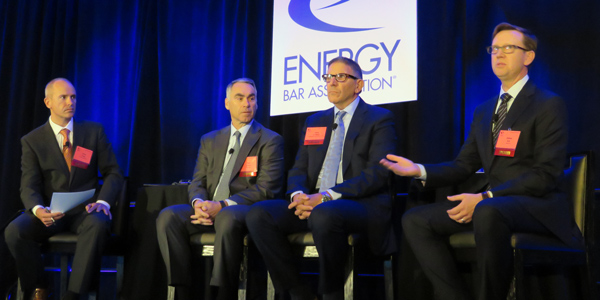By Rich Heidorn Jr.
WASHINGTON — Panelists at the Energy Bar Association’s Mid-Year Energy Forum last week heard two very different views of the health of wholesale markets.
Pacific Power CEO Stefan Bird was effusive in his praise of the Western Energy Imbalance Market (EIM), which saved parent company PacifiCorp almost $9 million in the second quarter of 2017. But Dynegy CEO Robert Flexon complained that CAISO and NYISO had become increasingly inhospitable to merchant generators because of state policies favoring renewables and nuclear generation, respectively.
“For us, the markets are [in an] incredibly fragile situation. California is a disaster. There isn’t any competitive power company out there who wants to put a nickel into California,” he said.
Flexon also bemoaned MISO Zone 4 in Southern Illinois, where he said competitive units face unfair competition from rate-based generation. The state also has approved zero-emission credits for nuclear plants, leading to fears in PJM — whose footprint includes Northern Illinois — that such subsidies will be contagious.
“PJM is doing everything they can to try to keep their market together. They’re very proactive,” Flexon said. “They’re trying to fix price formation and the like. [Having] half our megawatts in PJM, I feel good about that.” (See related story, PJM: Energy Price Formation Addresses DOE NOPR.)
Bird said his company’s experience with the EIM has been an unquestioned success.
Moderator Christopher R. Jones, a partner with Troutman Sanders, had set off the discussion by asking Bird if the markets are “healthy.”
“Are they enabling what our customers want? Are they enabling [a] low-cost, affordable, reliable future? I think the answer is resoundingly ‘yes,’” said Bird, whose company has 740,000 customers in Oregon, Washington and California.
“We’ve really had unprecedented opportunities to move that dial on a very accelerated pace and lower costs as well as reduce emissions.”
He said the EIM’s economic dispatch and its ability to move renewable power to load centers enabled PacifiCorp to announce in June a $3.5 billion investment in renewables and transmission in Wyoming, Utah and Idaho “at very little to no costs for our customers and savings over the long term.” (See PacifiCorp IRP Sees More Renewables, Less Coal.)
John DiStasio, president of the Large Public Power Council, said his members don’t have a single view of the market. His organization, which represents the 26 largest members of American Public Power Association, has members in NYISO, SPP and ERCOT.
“Those members that view that there’s economic benefits for them are participating in markets, and those who don’t see that don’t [participate],” DiStasio said.
He said RTOs have gone through “identity crises.”
“When we started up with CAISO, it was really a traditional RTO. And at some point, state policy started to drive how they looked at supporting environmental policy as well. There’s been hit and miss on how that’s been priced. There’s been hit and miss on how you get the right incentives for capacity in some of the markets.” DiStasio said California’s dominance of CAISO has been a barrier to greater market expansion in the West.
“Having said that … moving energy over wider regions I think is going to have a certain inevitability to it where we’ll have more and more people operating in markets — even if it’s just at the EIM level.
“From a Western perspective, I was appreciative that FERC didn’t try to push the Energy Imbalance Market. Actually, it would have fallen apart had that happened given the history of the [2000-2001] energy crisis, the [1980 Pacific Northwest Electric Power Planning and Conservation Act], given what happened in the Northwest during the energy crisis. I think FERC trying to assert more control at that time actually would have had a negative effect. Now, the market dynamics seem to have emerged organically enough that you have people that are voluntarily creating critical mass.
“I think this is really going to be a delicate balance going forward with how much does FERC push on state policy, and I think they may have to rethink the whole paradigm at some point. Because it is a clearly a hybrid and we’re kind of stuck … in no man’s land.”
When the discussion turned to Energy Secretary Rick Perry’s call for price supports for coal and nuclear plants, Flexon also called for FERC action.
“FERC has been missing while all the mischief has been happening,” he said, referring to the agency’s six months without a quorum. “They need to get back in the game and protect the markets they created.”








